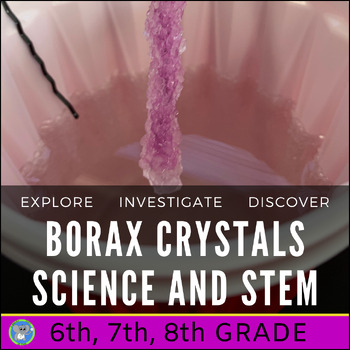Christmas Science Activity | Borax Crystal Growth Experiment | GR 6 7 8
- PDF
What educators are saying
Also included in
- A Complete 2nd-8th Grade Crystal Science and STEM unit. Differentiated worksheets save you time with lesson planning. Materials are inexpensive and results in 24 hours. Teacher guide and alignment to NGSS included. Students will discover borax crystal formation with a memorable hands-on lab and SPrice $11.40Original Price $14.25Save $2.85
Description
Discover the properties of mixtures and solutions by growing borax crystals.
You'll get a comprehensive teacher guide, a hands-on investigation gear for middle school, and a borax ornament STEAM challenge. This unit uses inexpensive materials and gives results in 24 hours, a wonderful way to reinforce the scientific method and journal writing.
This hands-on Investigation and Teacher Guide Includes
- Teacher Guide and Background Information and Tips
- Alignment to Standards
- 6 Page Student Investigation Journal
- STEAM Crystal Creation Worksheet and Activity
- Rubric
- Answer Key
- Terms of use
This investigation meets the Next Generation Science Standards
- NGSS Structure and Properties of Matter 6-8
- 6-8 Science and Engineering Practices
Students will test how different types of water affect crystal growth. Students will create supersaturated solutions and discover that distilled water is a pure substance and other types of water may not be. In the investigation, the students will create a hypothesis, record data, calculate the mean, and create a graph. Students will be guided in writing a summary and conclusion using their evidence. They will use their new knowledge to create a Christmas ornament, design of choice, or a crystal snowflake.
Teachers will appreciate the step-by-step directions, journal layout, and taking crystal making up a notch. This activity is excellent for science fairs, classrooms, clubs, or science camps. Teachers can use it to prepare students for the You Be the Chemist Challenge. All supplies can be found at the grocery store. I can tell you from experience that the students will think like scientists and enjoy discussing the results.
Supplies: Borax Powder, Tap Water, Distilled Water, Mineral Water, Popsicle Sticks, Pipe Cleaners, Heat Resistant Plastic or Glass Jars (Plastic is best.), Spoons, Measuring Spoons, Measuring Cups. You will need a scale for weighing the crystals.
Important: Borax crystals may sometimes stick to the container and be impossible to get off. Heat-proof plastic containers clean the best. If you use a glass beaker, test one first to see what happens. You can double-layer disposable cups.
This investigation is part of a series. This is the 6th/7th/8th-grade version. Please click each grade level version below to see more details.
Borax Crystal Lab: Investigate the Type of Water on Crystal Growth Grade 2/3
Borax Crystal Lab: Investigate the Type of Water on Crystal Growth Grade 4/5
Do you need multiple grade-level versions as a science lab teacher or for differentiation? Purchase the Bundle and save 20% on each resource.
STEAM Lab: Borax Crystal Lab: 3 Grade Level Bundle
If you like this, you may also like
Elephant Toothpaste: Explore, Investigate, Discover Exothermic Reactions
Exploring Gravitational Potential Energy and Work: Marble Roller Coasters
Cartesian Diver STEM: Density, Sinking, and Floating Exploration
Remember, leaving feedback earns you points toward FREE TPT purchases. We love hearing how the investigation went.
Also, follow us and be notified when new explorations are uploaded and deals.
Please contact us with any questions. We are here to help.
Yours in Science,
Kim@kimberlyscottscience.com
Inspiring Lifelong Learnings through a Memorable Scientific Experience
All parts are copyrighted. Please see the terms of use in the download. Please use good lab practices. The seller is not responsible for the use or misuse of the activities.






